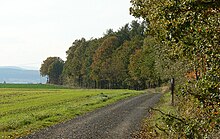Top wood
The Oberste Holz is a mixed forest north of the Eder and south of the Ems in the area of the town of Fritzlar in the Schwalm-Eder district in northern Hesse . The commercial forest managed by the Hessian Forestry Office as the Gudensberger Stadtwald is also used for hunting and as a recreational area.
Geographical location
The forest lies between the Gudensberg district of Obervorschütz in the north, the Felsberg district of Niedervorschütz in the northeast, the Wabern district of Niedermöllrich in the southeast, the Fritzlar district of Cappel in the south, and the Fritzlar district of Obermöllrich in the southwest and Werkel in the northwest.
history
Historically, the almost flat piece of forest consists of the western "Obersten Holz" and the eastern "Bonner Holz" or "Boner Holz". The Oberste Holz is on the site of a former jungle and swamp area. To the west of this is the geographical point "Hoher Mahlstein", the former location of the Hilgenstein von Werkel, which was probably built in the 3rd century BC. BC as the center of a ritual pre-Christian site. In Bonn wood there are remains of several Bronze Age barrows from the 2nd millennium BC. BC, which, however, have not yet been archaeologically examined. The after his fox named was "Fuchsküppel", with 217 m above sea level. NN the highest point within the forest, is the remainder of an eroded Bronze Age barrow.
The "Sälzerweg" , which had been exposed since the deforestation in 1946 and 1947 and connected the salt production sites in Bad Sooden-Allendorf with the Rheingau and today's Ruhr area , led through the Oberste Holz . The Sälzerweg on Obersten Holz is congruent with the Ederauenweg and an art trail sponsored by the Ars Natura Foundation.
In the Middle Ages the forest was also used as a hut forest . The oldest tree, the "thick oak", whose age is estimated to be 850 years, comes from this time. The names of the paths from Obervorschütz to Obersten Holz, "Heiseler Weg" and "Hommerweg", come from the Middle Ages. The Hommerweg is named after the roaring cattle that were herded to the hut pasture in the Obersten Holz.
In 1761, during the Seven Years' War , 12,000 French soldiers camped in Oberste Holz and besieged the Felsburg near Felsberg. The "equestrian grave" planted with two linden trees and in which a French officer and his horse are buried comes from this period .
The “Fasanenhof” belonging to the Wabern Hunting Lodge came from the 19th century . He served the bred for hunting water supply, from Japan introduced pheasants . Today only the well, which was restored in 1971 and finally sealed, is reminiscent of the Fasanenhof.
To the east of Obersten Holz, a mock airfield was operated from 1943 to 1945 during the Second World War . After the end of the war, military equipment lying around in the surrounding villages and weapons collected by the Allies were gathered in the Obersten Holz and destroyed. Two explosion funnels filled with rainwater are leftovers from this campaign. From 1947 to 1952 the war damage was compensated by afforestation.
The Waldläufer community of interests built the “Bonner Holz” refuge with a children's swing in 1970 and the “New Refuge” at the forest pond in 1971; the Obervorschützer painter Konrad Giese designed both shelters with oil paintings. On April 6, 1977, a free-standing Evangelical Lutheran altar was consecrated in the middle of an oak dome on Sälzerweg. In November 1988, pupils from the Fritzlar König-Heinrich-Schule planted a wood in the field east of Oberste Holz, which offers protection against wind and soil erosion, improves the microclimate and provides a habitat for small organisms.
In 1992, a waste wood consisted of was from the Hessian Forestry Office oaks and Book excluded, and on the eastern edge of the forest from further economic use to one of nine throughout Hesse oaks - and ten sycamore attempt acreage designated. The offspring of various Hessian pedunculate oak and maple stands are to be analyzed in these areas in order to check their adaptability, vitality and quality and to select a sufficient number of suitable seed stands for each region of Hesse.
Recreation area

The Oberste Holz is a popular destination for excursions and forest walks. Parking spaces are available in front of the Cappeler and Obervorschützer forest side. The Oberste Holz is an ideal place for forest walks, jogging, Nordic walking, mountain biking and cross-country skiing; it was even used as a training track for dog sled races.
Since 2004, the Ars Natura art trail has been leading through the forest area via the Barbarossaweg (hiking sign "X8") . The work “The Memory of Stones” by the Göttingen artist Joachim Reitner will be shown, the Allendorf artist Alf Becker will show his “District Situation I”, the Malsfeld artist Lutz Lobert his work “Aufbruch”, and the Schwalmstadt artist Ursula Porada her “Magical Grove “In the immediate vicinity of the Protestant altar and in the vicinity of the tree nursery .
literature
- Richard Brachmann: Festschrift for the Obervorschütz Heimatfest from June 17 to 19, 1955, Mayor's Office Obervorschütz (Ed.), 1955, p. 61
- Eduard Brauns: Hiking and travel guide through North Hesse and Waldeck. A. Bernecker Verlag Melsungen, 1971
Coordinates: 51 ° 8 ′ 11 " N , 9 ° 20 ′ 45" E


